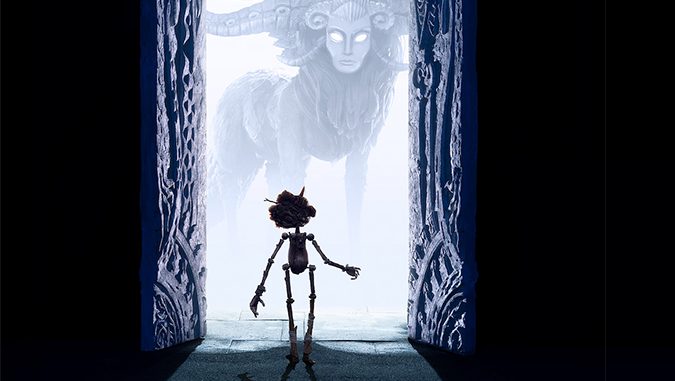
Distribution Service: Netflix
MPAA Rating: PG
USCCB Rating: Not rated at the time of this review
Reel Rating: 2 out of 5 reels
The Adventures of Pinocchio by Carlo Collodi, first published in 1883, is one of the great Christian allegories of the 19th century. Like Pilgrim’s Progress or The Chronicles of Narnia, it was designed to bring Christian themes into family-oriented literature. It has been adapted to film dozens of times, but the results have never exceeded the 1941 Disney feature, a masterpiece of animated cinema.
Guillermo del Toro’s version blends the original story with common tropes, including complicated morality, existential crises, 1930s fascism, and lots of monsters. Yet despite the presence of positive Catholic imagery, it misses the allegory and substitutes a mess of platitudes with no coherent structure. This Pinocchio isn’t lifeless, but he’s certainly not a real boy.
The story begins in Italy during the Great War. Geppetto (David Bradley) and his beloved son Carlo (Gregory Mann) are carving a new crucifix in the local church when a rogue bomb drops from above, killing the boy. Twenty years later, the broken-hearted father still has not finished this project. In a drunken rage, he cuts down the tree next to Carlo’s grave and poorly carves a haphazard wooden puppet. That night, a Wood Sprite (Tilda Swinton) gives Pinocchio life despite Geppetto not entreating this gift. While perhaps not having a rational soul, he certainly acts like a mischievous eight-year-old: curious, naïve, argumentative, and always getting into trouble.
All children struggle with morality, but this is especially hard when you live in a society where “good” and “bad” are up for grabs. He gets limited help from Sebastian (Ewan McGregor), a cricket who lives in his head but seems more interested in writing his memoirs than guiding Pinocchio on the straight and narrow. Like Forrest Gump, he ebbs and flows through society, trying to make sense of everything before offering the ultimate sacrifice.
The first thing the Wood Sprite tells Pinocchio is to “be good,” but no one takes the time to explain what that means. At one point, Geppetto tells him that war is bad because it took Carlo from him. Yet, the local government authority Podesta (del Toro regular Ron Pearlman) tells him war is good because it makes the country strong. Thus, Pinocchio is more in the vein of Huckleberry Finn than an obvious morality play like the Disney original.
Further complicating the matter is the afterlife. As a golem-like creature, Pinocchio cannot die. When a fatal event occurs, he temporarily goes to the afterlife, a Hades like realm governed by Death – here a Sphinx-like creature – only to return hours or days later. Without Heaven or Hell, the stakes are not terribly high.
All of this changes, however, when Pinocchio dies trying to save Geppetto at sea. He demands to be sent back immediately to rescue his “papa.” Death warns that to return before his appointed time means becoming mortal. He agrees and drowns while getting Geppetto to safety. This act mirrors Jesus’s famous adage that there “is no greater love than this: to die for one’s friends.” Perhaps he did learn something after all.
Another theme del Toro explores is Pinocchio’s desire to be “a real boy.” In the Disney version, a human being is obvious: flesh and blood with a rational soul. Again, this adaptation never makes clear what “real” means, so Pinocchio must discover his identity. He teams up with an abusive puppet master who teaches him that wealth and fame bring meaning. Podesta, echoing Mussolini, insists it comes through power. Pinocchio is voiced by the same actor as Carlo, suggesting he has something of the soul of Geppetto’s son. But at no point does he become human, implying that souls are not limited to Homo sapiens, an idea promoted frequently in del Toro’s work. In the end, it is defined by love and mortality. Having limited time makes life precious, and loving others demonstrates consciousness.
The films of del Toro are famous for their fantastical religious universes. His syncretistic worldview blends Christianity with pagan entities. Catholicism is portrayed positively but as an extension of cultural cohesion rather than as a spiritual reality. The town’s priest is kind but also never resists the rise of fascism. Instead, the world is full of spirits, something like Japanese kami. The highest beings, the Wood Spite and Death, borrow heavily from Old Testament angelic imagery with dozens of eyes and wings.
All this could be confusing for small children, one of the many reasons they should probably stay away.
Pinocchio tries desperately to address many difficult issues, but never fully realizes anything. It doesn’t commit to being a classic Christian allegory nor does it fully embrace its pagan ideas. The key can be found in Pinocchio’s creation, which was not made from love, but from a haphazard attempt at meaning born from sorrow. Geppetto would have done better to pray for Carlo, bring his grief to the cross, and help the other children of the village. It’s not as interesting as a story, but would have saved a lot of fuss.
If you value the news and views Catholic World Report provides, please consider donating to support our efforts. Your contribution will help us continue to make CWR available to all readers worldwide for free, without a subscription. Thank you for your generosity!
Click here for more information on donating to CWR. Click here to sign up for our newsletter.







When will we Christians understand how necessary it is to live separately from the cultural detritus that surrounds us instead of immersing ourselves in it and then complaining about it. Yes, we need to be fully informed about the culture we live in and yet not allow ourselves to become part of it.